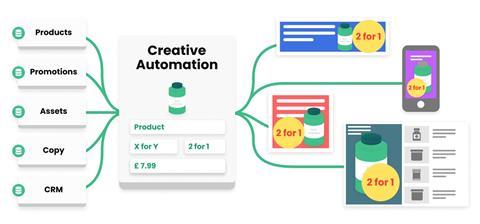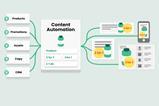With retail marketing becoming ever more complex, Relayter examines how to boost output without overloading your workforce
From evolving ad formats and a growing number of marketing channels to stricter ad regulations and the need for more personalised content, the world of marketing has evolved dramatically in recent years.
As a result, marketing teams are under pressure to produce an ever-growing number of diverse content assets.
One solution is to hire more creative staff in-house or increase the production budget for external agencies. But even for the biggest retailers, there are physical and financial limits to this.
Creative automation offers several ways to help retailers solve these complexities. Giving the ability to cut down on repetitive tasks, scale up content output and increase the production speed.
What is creative automation?
When it comes to product promotion, generalised social banners, in-store material and sales, leaflets simply aren’t enough anymore.
Retailers need multiple variants for different social platforms, several segmented variants for CRM and localised POS materials in different regions.
Stripping it all back and using category management data provides respite for staff as technology can interpret promotional and product statistics in a structured and logical way.
For instance, how should certain promotions look in different channels? Or how is the style defined for various CRM segments?

Creating a specific set of rules and design-system logic for yourself, even if it is just in writing, is the base for automating creative work.
It is then possible to create smart automation templates that handle this input and create all the variants and localised versions of your promotions for any given channel.
And this is all based on the same promotional input that would otherwise just be (manually) used to create one or a few specific content items.
What are the key benefits for retail?
- Go to market faster: With a strong automated promotional workflow, from category management and trade to creative production, retailers can save 50% or more on production times. Getting content ready for print and digital distribution becomes a lot faster.
- Win back creative time: Repetitive tasks can be handled, allowing marketing teams to focus on strategy, creativity and innovation.
- Scale up creative production: Retailers can scale their marketing content output 10x or more without increasing their workforce.
- Optimise content performance: Content can be created at scale and also tried, tested and optimised in a much more cost-efficient way.
- Personalise and localise: Retailers can create segmented CRM-based online and offline content in any region or channel.
- Streamline campaign management: Campaign creation, execution and optimisation is streamlined. Retailers can use this automation to schedule and deploy marketing campaigns across multiple channels simultaneously, ensuring consistency in messaging and branding.
Three things to consider
1. Build a team
The three main stakeholders – category management, marketing and IT – must be aligned. Everybody needs to understand that this is a process to get a retail organisation future-proofed and ready for the next big wave in marketing execution.
It will take time, guts and a lot of good conversation to standardise promotional data, set up business rules, get the right software tooling and align the process for everybody involved.
2. Promotion standardisation
Try to bring down the many creative and well-meant custom promotion ideas back to a few good structured sets of mechanisms.
Also, find a way to structure design and brand elements for all your possible marketing channels so that the brand consistency is high but flexible enough for different scenarios.
Do not be afraid of complexity but make it clear and reusable. This becomes the base for scalable content output.
3. Document your logic
You need a good set of well-documented business and design logic to get the right output with creative automation.
A written guide as to how various promotional types and mechanisms should look in different marketing channels. Preferably with visual examples. But also how brand guidelines should be interpreted in various outcomes.
This will go much further than a brand book or style guide. Document how (promotional) data will transform into each creative outcome. It will become the creative automation bible for everyone and the main reference guide to all content production.
To find out more about creative automation or view cases from AS Watson, Spar and Ahold Delhaize, click here.




























